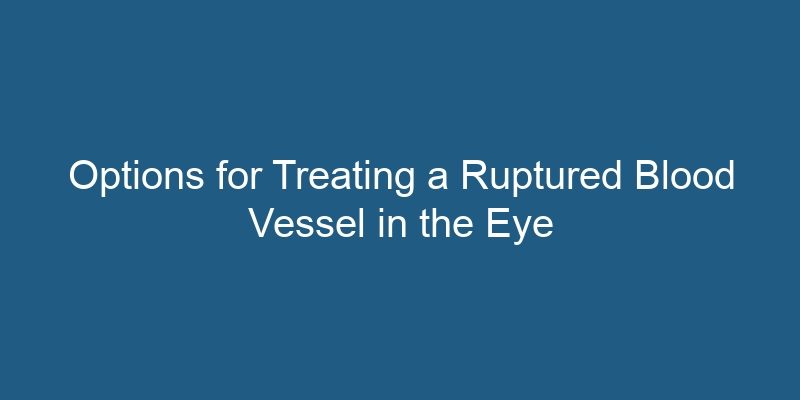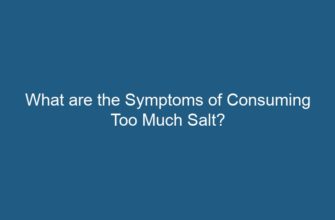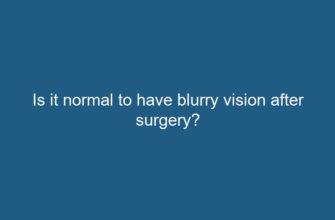A ruptured blood vessel in the eye, also known as a subconjunctival hemorrhage, can be a cause for concern. It occurs when a blood vessel in the conjunctiva, the clear tissue that covers the white part of the eye, breaks and causes blood to pool under the conjunctiva. While subconjunctival hemorrhages are typically harmless and resolve on their own within a few weeks, some individuals may seek treatment to alleviate discomfort or reduce the appearance of the blood in the eye. In this article, we will explore various options for treating a ruptured blood vessel in the eye.
- 1. Observing and Monitoring
- 2. Artificial Tears and Lubricants
- HOW TO TREAT BROKEN BLOOD VESSEL IN EYE: what does it mean & how to treat bleeding or bloodshot eye
- How do I treat a broken blood vessel in my eye? – Ask an Ophthalmologist
- 3. Cold Compresses
- 4. Prescription Eye Drops
- 5. Eye Patching
- 6. Surgical Intervention
- 7. Prevention and Lifestyle Changes
- 8. Natural Remedies
- Frequently Asked Questions (FAQs)
- FAQ 1: Is a ruptured blood vessel in the eye a serious condition?
- FAQ 2: Can I speed up the healing process of a subconjunctival hemorrhage?
- FAQ 3: Can a subconjunctival hemorrhage affect my vision?
- FAQ 4: Can stress cause a ruptured blood vessel in the eye?
- FAQ 5: Can I wear contact lenses with a subconjunctival hemorrhage?
- FAQ 6: When should I seek medical attention for a ruptured blood vessel in the eye?
- Conclusion
1. Observing and Monitoring
In most cases, a ruptured blood vessel in the eye will heal naturally over time. The initial step in treatment is often to observe and monitor the condition without intervention. It is crucial to avoid rubbing the eye, as this can worsen the hemorrhage or lead to additional complications. Additionally, it is recommended to refrain from using contact lenses or applying eye makeup until the blood has cleared.
2. Artificial Tears and Lubricants
Using artificial tears or lubricating eye drops can help alleviate any discomfort or dryness associated with a subconjunctival hemorrhage. These over-the-counter products can moisturize the eye and provide temporary relief. It is important to choose preservative-free options to avoid any potential irritation.
HOW TO TREAT BROKEN BLOOD VESSEL IN EYE: what does it mean & how to treat bleeding or bloodshot eye
How do I treat a broken blood vessel in my eye? – Ask an Ophthalmologist
3. Cold Compresses
Applying a cold compress to the affected eye can help reduce swelling and alleviate any discomfort. The cold temperature can constrict blood vessels and minimize the extent of the hemorrhage. To create a cold compress, wrap a clean cloth or ice pack in a thin towel and gently place it on the closed eye for 10-15 minutes at a time, several times a day.
4. Prescription Eye Drops
In certain cases, a healthcare professional may prescribe eye drops, such as vasoconstrictors or decongestants, to help reduce the appearance of the blood in the eye. These medications work by constricting blood vessels and minimizing the redness. However, it is important to consult with a healthcare professional before using any prescription eye drops.
5. Eye Patching
In rare instances where the subconjunctival hemorrhage is extensive or causes significant discomfort, an eye patch may be recommended. The patch helps protect the eye and prevent further irritation or injury. It is essential to follow the healthcare professional’s instructions regarding the duration and usage of the eye patch.
6. Surgical Intervention
While surgical intervention is not typically necessary for a ruptured blood vessel in the eye, there are rare cases where it may be considered. If the hemorrhage is caused by an underlying condition, such as a blood clotting disorder, surgical treatment may be required to address the root cause and prevent future occurrences. It is crucial to consult with a healthcare professional to determine if surgical intervention is necessary.
7. Prevention and Lifestyle Changes
In some instances, a subconjunctival hemorrhage may be a result of high blood pressure, trauma to the eye, or other underlying factors. Making lifestyle changes, such as managing blood pressure levels, wearing protective eyewear, and practicing good eye hygiene, can help prevent future occurrences of a ruptured blood vessel in the eye.
8. Natural Remedies
Although scientific evidence is limited, some individuals find relief from a subconjunctival hemorrhage by using natural remedies. These include applying chamomile tea bags or aloe vera gel to the affected eye, which are believed to have anti-inflammatory properties. However, it is important to consult with a healthcare professional before trying any natural remedies.
Frequently Asked Questions (FAQs)
FAQ 1: Is a ruptured blood vessel in the eye a serious condition?
A ruptured blood vessel in the eye is typically not a serious condition and often resolves on its own within a few weeks. However, if you experience severe pain, vision changes, or recurrent subconjunctival hemorrhages, it is important to consult with a healthcare professional to rule out any underlying conditions.
FAQ 2: Can I speed up the healing process of a subconjunctival hemorrhage?
While there is no guaranteed way to accelerate the healing process, following proper eye care practices such as avoiding eye rubbing, using lubricating eye drops, and applying cold compresses can promote faster healing and alleviate discomfort.
FAQ 3: Can a subconjunctival hemorrhage affect my vision?
A subconjunctival hemorrhage typically does not affect vision. However, if you experience any changes in your vision or have concerns, it is recommended to consult with an eye care professional.
FAQ 4: Can stress cause a ruptured blood vessel in the eye?
Although stress is not a direct cause of a subconjunctival hemorrhage, it can potentially contribute to high blood pressure, which is a risk factor for the condition. Managing stress levels and practicing relaxation techniques may help reduce the likelihood of developing a ruptured blood vessel in the eye.
FAQ 5: Can I wear contact lenses with a subconjunctival hemorrhage?
It is generally recommended to avoid wearing contact lenses until the blood has cleared and the eye has fully healed. Contact lenses can potentially irritate the eye or impede the healing process.
FAQ 6: When should I seek medical attention for a ruptured blood vessel in the eye?
While most cases of subconjunctival hemorrhages do not require medical attention, it is advisable to consult with a healthcare professional if you experience severe pain, vision changes, recurrent hemorrhages, or have any concerns about the condition.
Conclusion
A ruptured blood vessel in the eye, or subconjunctival hemorrhage, is a common and usually harmless condition that resolves on its own. However, individuals may choose to pursue treatment options to alleviate discomfort or reduce the appearance of the blood in the eye. Observing and monitoring the condition, using artificial tears, applying cold compresses, and considering prescription eye drops are among the various treatment options available. Surgical intervention is rarely required but may be necessary in certain cases. Preventive measures, lifestyle changes, and natural remedies can also help prevent future occurrences. It is important to consult with a healthcare professional for an accurate diagnosis and appropriate treatment plan for a ruptured blood vessel in the eye.










